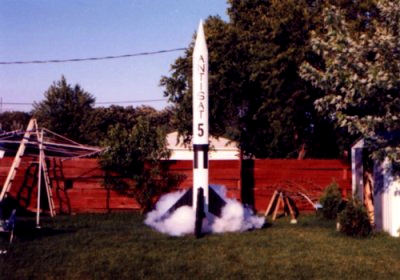

Antisat 5 Gary's backyard, 1980(?)
Just a prop made, by Gary, from airduct tube. A prop for a video we were going to make. The smoke is a small black powder charge.
See? I've always been into this kind of thing. This was the largest rocket project I'd been involved with...until now.
 The Awahili. Awahili is Cherokee for eagle.(Enough of these Greek & Roman names for rockets!) It is a model of a 4 stage sounding rocket. If weight estimates for the model are accurate, our computer simulations put the top altitude for the 4th stage around 17,000 feet!
The Awahili. Awahili is Cherokee for eagle.(Enough of these Greek & Roman names for rockets!) It is a model of a 4 stage sounding rocket. If weight estimates for the model are accurate, our computer simulations put the top altitude for the 4th stage around 17,000 feet!
We're building a new type of ejection system for the Awahili as well. Recovery seems to be the weakest link in a successful rocket flight. If the black powder ejection charge fails - no parachute! And then the rocket "lawn darts" or "core samples". Our system is based on a CO2 cartridge as the "ejection charge". An electronic valve will keep firing the CO2 until parachute deployment is indicated. Jim is an electrical engineer and is hard at work on the electronics for the system. (More on this project as it evolves.)
In the photo at left is the unpainted Awahili next to the PML Quasar (the rocket in the Danville photos and the one I'm holding in front of my Jeep). It's four inches in diameter and just over 14 feet high. The airframe is phenolic tubing (cardboard tube impregnated with epoxy) and the fins are G-10 fiberglass & clear plexi. The nosecone is injection molded plastic and a machined aluminum collar and cap system is installed in the airframe end for holding the motor casings in the airframe. The rocket will be painted yellow, white and brown, like the bald eagle it's named for.
We're hoping to test fly a single stage of the rocket to test the recovery system in the next couple of months. Stay tuned!
Back to the HPR main page
Back to the main page.


 The Awahili. Awahili is Cherokee for eagle.(Enough of these Greek & Roman names for rockets!) It is a model of a 4 stage sounding rocket. If weight estimates for the model are accurate, our computer simulations put the top altitude for the 4th stage around 17,000 feet!
The Awahili. Awahili is Cherokee for eagle.(Enough of these Greek & Roman names for rockets!) It is a model of a 4 stage sounding rocket. If weight estimates for the model are accurate, our computer simulations put the top altitude for the 4th stage around 17,000 feet!